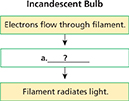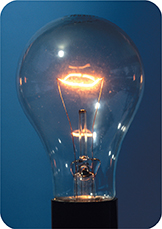18.5 Sources of Light
Reading Focus
Key Concepts
 What are the six common sources of light?
What are the six common sources of light? How does each type of light source generate light?
How does each type of light source generate light?
Vocabulary
luminous
incandescent
fluorescence
phosphor
laser
coherent light
Reading Strategy
Sequencing Copy and complete the flowchart below. As you read, pick two other light sources and complete a similar flowchart showing how each source generates light.

As sunlight fades toward the end of the day, objects around you become less and less visible. When the sun has completely set, you can no longer see your surroundings. Objects are invisible in the dark because no light is available to reflect off them. But some things, such as flashlights and fireflies, produce their own light. Objects that give off their own light are luminous. The sun is luminous, as are all light sources.
 Common light sources include incandescent, fluorescent, laser, neon, tungsten-halogen, and sodium-vapor bulbs. Each type of bulb produces light in a different way.
Common light sources include incandescent, fluorescent, laser, neon, tungsten-halogen, and sodium-vapor bulbs. Each type of bulb produces light in a different way.
Incandescent Light
The light produced when an object gets hot enough to glow is incandescent. Figure 27 shows an incandescent light bulb. Inside, you can see the filament, a thin coil of wire stretched between two thicker wires.  When electrons flow through the filament of an incandescent bulb, the filament gets hot and emits light.
When electrons flow through the filament of an incandescent bulb, the filament gets hot and emits light.
Figure 27 An incandescent bulb contains a filament. As electrons flow through the filament, the filament gets hot and emits light. Formulating Hypotheses Why is a 100-watt bulb generally brighter than a 75-watt bulb?

The filaments in incandescent light bulbs are made of a substance called tungsten. Incandescent light bulbs are filled with a mixture of nitrogen gas and argon gas at very low pressure. These gases do not react with the filament as oxygen would, and so the filament lasts longer. Incandescent bulbs give off most of their energy as heat, not light.




